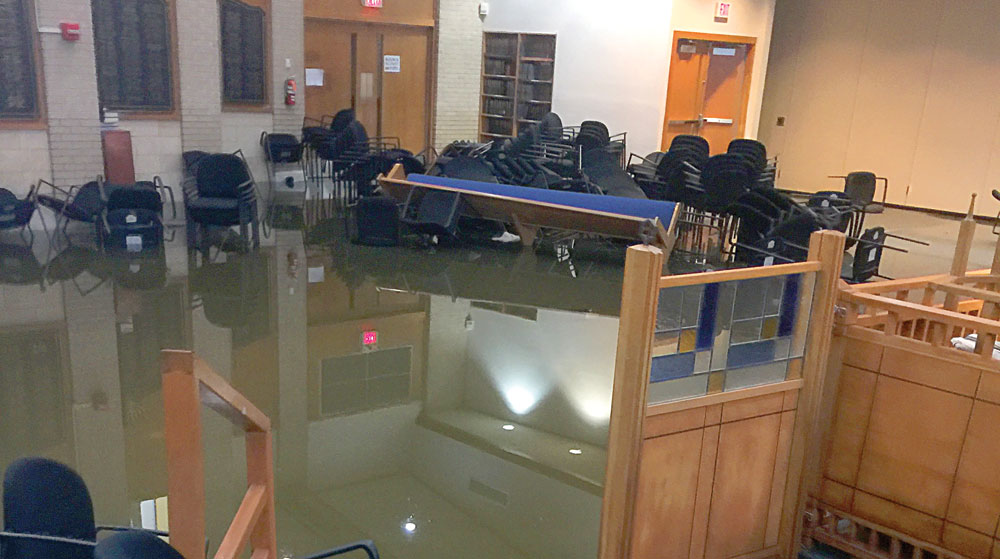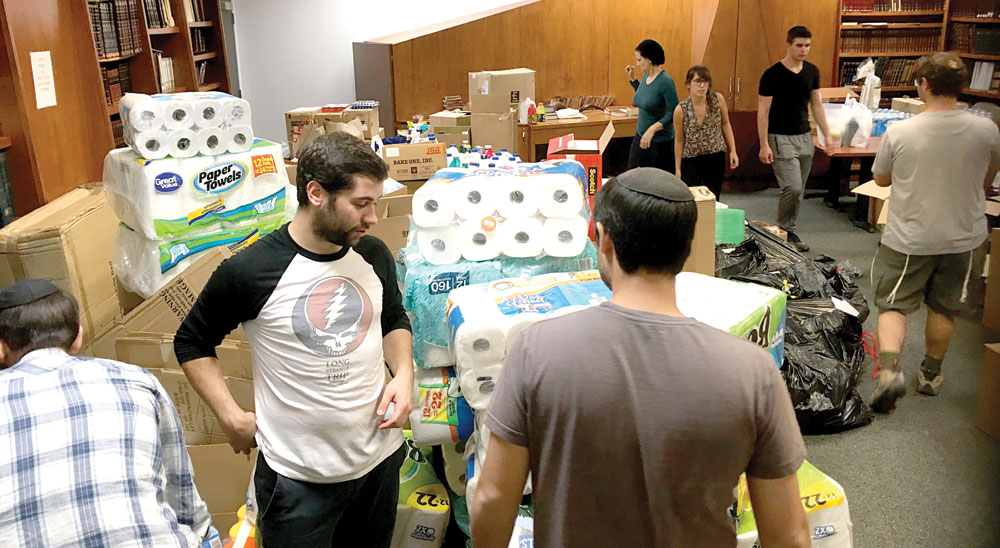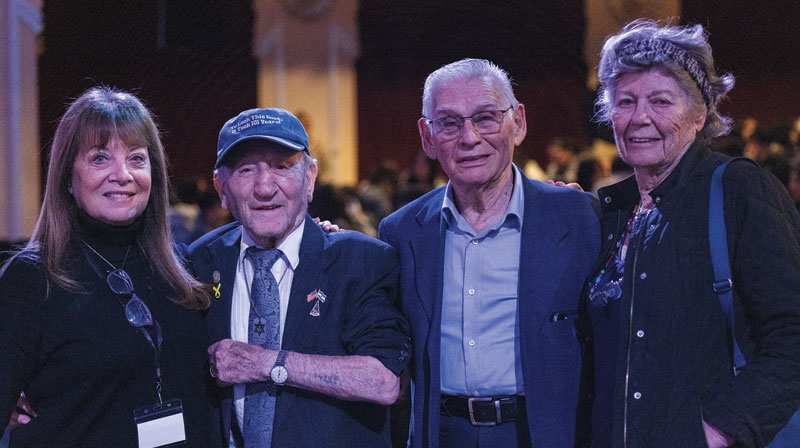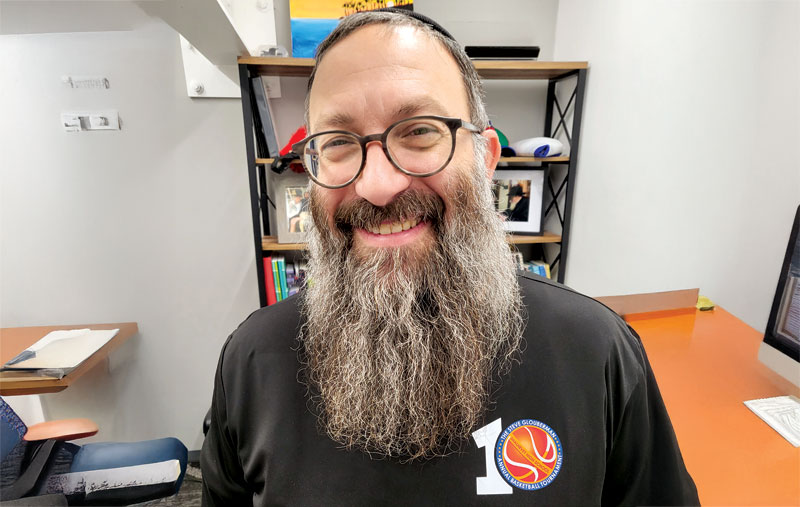
The extraction team gathered in the parking lot of Congregation Beth Yeshurun as the waters rose in Houston, 13 men and boys braving the flooded roads in their SUVs.
Inches of rain from Hurricane Harvey had collected in the synagogue’s lobby, with its display cases holding Judaica that dates back centuries. Things were more dire in the main sanctuary, with tiered seating for more than 3,000, where the water level was more than 4 feet high at the base of the bimah.
[Hurricane Harvey: How you can help]
Being careful not to slip, the group approached the holy ark to carry the 25-plus Torahs to safety.
“It had to be done, now,” said Gary Swartz, a 46-year member and past president of the Conservative synagogue, among the nation’s largest with more than 2,000 families.
The Torahs’ rescue took place Aug. 27, the second day of a historic storm that dropped more than 50 inches of rain on some sections of southeast Texas. Swartz had called some friends, along with his son and son-in-law, to undertake the extraction. Swartz’s grandson, who became a bar mitzvah a year ago, was the youngest member of the rescue party.
“I said, ‘You need to come to the shul — now. We’ve got to get those Torahs out — now.’ We met at 3 o’clock and we started schlepping, and we were gone before 4. The flooding never got worse in there, maybe inches, but the moisture and the humidity and the smell was” — he paused for a moment, reaching for the right word — “special.”
“Everything in the world was in that water,” Swartz said over the phone. “Raw sewage — you had everything.”
The men removed the Torahs one by one, wrapping them in garbage bags and using umbrellas to keep them dry as they shuttled the scrolls to the parking lot. They returned to clear out the Torahs from the other prayer spaces, more than two dozen altogether, so they could be stored, high and dry, in private residences.
It likely will be months or more before the scrolls can return home.

Brays Bayou, a slow-moving waterway that runs 31 miles east-west across metropolitan Houston, cuts less than 1,000 yards from the synagogue, separating Meyerland and Willow Meadows, two hubs of Houston’s Jewish community on the west side of downtown. During the storm, parts of the waterway quickly turned into a lake, inundating Congregation Beth Yeshurun on the north bank and the United Orthodox Synagogues of Houston (UOS), located about 500 feet from the bayou to the south. (A Reform temple about 3 miles down the bayou to the west, Congregation Beth Israel, also was flooded.)
Together, Congregation Beth Yeshurun and UOS sustained an estimated $10 million in damage. As repairs begin that could take longer than a year, the wreckage of the two synagogues provides a snapshot of the larger community’s devastation and the determination of Houstonians to take the first steps in the long, slogging return to normalcy.
Shortly after the floodwaters receded, Rabbi Barry Gelman drove out of the parking lot of UOS, onto the leafy streets of Willow Meadows. As he passed a pile of drywall that had been ripped out of the synagogue, he turned a camera onto the nearby homes.
“As I drive out of the shul and through the neighborhood, you’ll be able to see the remnants of people’s lives as they are strewn all over the yards in the front of everyone’s houses,” he says in the video.
A cheerful blue sky throws into sharp relief the piles of wreckage on the front lawns of ranch-style homes below — furniture and personal belongings waiting to be hauled away. As he passes a particularly hard-hit block a two-minute walk from the synagogue, he calls out some of the items he sees — “couches, dining room tables, dressers, recliners, mattresses, rocking chairs, lamps, headboards, art” — until he comes to his own home, similarly disemboweled of its ruined contents.
Even as the flood victims ripped apart their homes so they could start the recovery, some of the first rituals of daily life to come back were the morning and evening minyans, daily prayer quorums of 10 or more.
As soon as the roads became passable after the hurricane, UOS members gathered in private homes and at the nearby Robert M. Beren Academy so that those who lost loved ones in the past year could recite the mourning prayers for their dead.

“You’re pushed into a sense of helplessness when water’s coming in and there’s nothing you can do to stop it,” said Robert Levy, a member of the executive committee at UOS. “To be able to be together, to daven three times a day, to look forward to Shabbat, is incredibly important.”
After floods in 2015 and 2016, the congregation built a social hall on higher ground in which to gather after crippling storms. During Harvey, however, it took on a foot of water — still better than the 5 or 6 feet in other parts of the synagogue. Photos from the aftermath show chairs and tables overturned, books spilled from shelves and a swamp of greenish water covering much of the floor space. Members managed to remove all but one of the shul’s Torah scrolls, and the floodwaters crested just before they reached the one that had been left behind.
By Shabbat, a week after the flooding started, the social hall at least had been returned to a serviceable condition.
The drywall had been ripped out and the room smelled a bit like bleach, Levy said, but some 200 people gathered, anyway. An old, portable ark had been salvaged, and folding tables served for the weekly reading, with congregants following along in photocopied packets — the Chumashim had been washed out. A number of community members read the gomel prayer, traditionally recited after a brush with death.
For Levy, it was difficult to pause for the traditional day of rest. His house had flooded; in addition, he was helping a friend who, unlike more seasoned storm veterans, saw his home flooded for the first time and was struggling. But Shabbat turned out to be a welcome reprieve from the seemingly endless slog, Levy said.
Contractors had been showing up at his home before 7 a.m. all week and staying late. By Saturday, Levy was sleep deprived. His neighbors hosted him for a Shabbat lunch but took mercy and excused him when they saw him nodding into his meal. Levy spent most of the afternoon sleeping.
“You recharge and then you move on,” he told the Journal by phone on Sept. 3, a Sunday. “And we all needed that. We needed the chance to have a break, to think about things, to start the healing process — in particular, that was important.”
For Congregation Beth Yeshurun, an easy 20-minute walk from UOS, Sept. 2, a Saturday, meant a bat mitzvah. The celebration couldn’t take place at the synagogue, which was still a disaster zone, and had to be moved to a nearby synagogue. Before normal functioning can resume at Congregation Beth Yeshurun, all the chairs have to be removed and replaced, the custom wood wall paneling stripped out and 100,000 square feet of carpet swapped out.
“It was absolutely mind-numbing and heartbreaking,” Larry Finder, an attorney and longtime member of Congregation Beth Yeshurun, said of the scene he encountered while helping to rescue the Torahs. “We’re not going to be able to have High Holy Day services there. We’re not going to have Shabbat services there.”
The daily minyan Finder attends in one of the auxiliary prayer spaces had been moved to private homes as repairs proceed. “I don’t know when we’re getting back in,” he said. “I don’t think anybody knows.”

About a mile to the north of Congregation Beth Yeshurun, Congregation Brith Shalom, led by Rabbi Ranon Teller, agreed to take in the displaced congregation for the Sept. 2 festivities. The family of the bat mitzvah girl, Rachel Rosenberg, had been stranded in Atlanta during the storm but managed to make it back late in the week, even though their out-of-town guests couldn’t, the Houston-based Jewish Herald-Voice reported.
“After speaking to our rabbi on Tuesday [Aug. 29], we agreed that in the Jewish religion, we go through with simchas and other important life-cycle events even during difficult times, such as these,” Jeffrey Rosenberg, Rachel’s father, told the paper.
“The show must go on,” he said.
The two Conservative synagogues have long enjoyed a close relationship, said Congregation Beth Yeshurun Senior Rabbi David Rosen. But the storm offered a “wonderful opportunity to us to strengthen our bond and be with one another during this time of loss and sorrow for our entire Jewish community and the city of Houston,” he said.
As the Rosenberg bar mitzvah kicked off Friday night, Sept. 1, Congregation Brith Shalom invited members of its sister synagogue to a free Shabbat meal there. The next morning, the building was crowded with congregants of both shuls, Rosen said.
“What was interesting and delightful was discovering how many of us knew them and how many of them knew us,” he said. “There reached a point where I couldn’t remember with many people if they were my members or Rabbi Teller’s.”
Efforts to rehabilitate Congregation Beth Yeshurun were hampered by the fact that many members, staff and clergy were struggling through their own personal tragedy and loss.
“We can’t ask people to come away from their own flooded homes and the flooded homes of their family and friends and neighbors to come here because our priority is still them,” said Rabbi Sarah Fort, a new addition to the synagogue’s clergy who moved to Houston recently from Los Angeles. “It’s the people that make up Beth Yeshurun, not the building.”
Swartz, the shul’s past president who helped coordinate the Torah rescue, said preliminary estimates of damage to the building ran as high as $5 million. At the day school attached to the synagogue, floods washed out textbooks, chairs, desks, electronics, students’ schoolwork and musical instruments, causing as much as another $3 million in damage.
“There’s not enough Clorox in the world to clean all that up,” Swartz said.
The school has started a relief fund to recoup its losses, which total significantly higher than its annual budget, Swartz said. The synagogue also opened a fund to cover its damages.

Among the largest jobs to be undertaken in the first days after the storm was the removal of damaged books. More than 1,000 prayer books were taken from the main sanctuary alone, Fort said, in addition to those removed from the other prayer spaces and the clergy offices, some of the books dating to the founding of the 120-year-old congregation.
“Rabbis like big, heavy Jewish books, so as you can imagine, there’s a lot of them,” Fort said.
Because Jewish law mandates that books containing the Hebrew name of God be buried, the synagogue plans to dig a massive genizah — a graveyard for books — in the grassy field that normally serves as an overflow parking lot, according to the rabbi.
For Fort, a recent graduate of the Ziegler School of Rabbinic Studies at American Jewish University, the storm comes as a trial by water in her first month on the job. Congregants had been apologizing to her for her canceled welcome party, a Texas-style “Rabbi Roundup,” which was supposed to have featured pony rides, line dancing and a world champion roper.
“It’s so funny, they’re apologizing to me,” Fort told the Journal. “It’s like, ‘Your house is flooded. Don’t worry about me.’ ”
A bright spot to the storm for the young rabbi was the way Houstonians, Jewish and otherwise, came together after the tragedy.
“As the new rabbi on the block, it really shows me the kind of community that’s here,” she said, “and it’s heartening.”
“We have always been the ones who have reached out and been there for everyone else,” said Rosen, the synagogue’s senior rabbi. “And to find ourselves this time, both personally and as a congregation, being the ones who need help has given me a new appreciation for just how generous and kind and outgoing a community can be.”
Speaking by phone as he swept drywall dust out of his home, Gelman, the UOS rabbi, said he was “amazed at people’s abilities, people’s fortitude, people’s courage and strength. I’m talking about the flood victims and the volunteers. People are just showing up.”
“Sometimes it takes a crisis to unite us,” he went on. “But this is what humanity should do, and I’m seeing it literally on a minute-by-minute basis.”
Illustration by Lynn Pelkey























 More news and opinions than at a Shabbat dinner, right in your inbox.
More news and opinions than at a Shabbat dinner, right in your inbox.